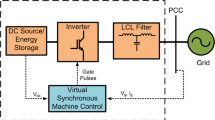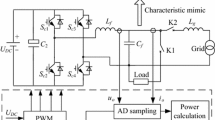Abstract
Rate of change of frequency (ROCOF) is an indicator of frequency stability of a power system network. Maintaining the ROCOF value within the acceptable limit is a major challenge with increasing penetration of converter-based renewable energy generation technologies. A virtual synchronous machine (VSM) is proposed in this paper as a ROCOF control device with a novel battery power management algorithm to extend the lifetime of the batteries. The VSM unit consists of a DC storage connected through a three-phase voltage source converter with a harmonic filter to the grid and the corresponding local control system. The Kundur two-area system is used as a test case to analyse the performance of the VSM. A hardware prototype of the VSM with 1 kW, 200 V and 50 Hz rating is developed in the laboratory environment. The modified Kundur two-area system and the control strategies are implemented in OPAL-RT real-time simulator. The effect of VSM on the modified Kundur two-area system is analysed using the power hardware-in-the-loop concept. The experimental results indicate that the VSM is effective in reducing the ROCOF values in power system networks during rapid fluctuations in frequency caused due to the load switching events. The hardware implementation of a VSM interfaced with the modified Kundur two-area system, the novel battery power management algorithm and the application of VSM as a ROCOF control device for power system applications are the unique contributions in this paper.













Similar content being viewed by others
References
Tielens P, Van Hertem D (2016) The relevance of inertia in power systems. Renew Sustain Energy Rev 55:999–1009
Meng X, Liu J, Liu Z (2018) A generalized droop control for grid- supporting inverter based on comparison between traditional droop control and virtual synchronous generator control. IEEE Trans Power Electron 34:5416–5438
Attya AB (2015) Integrating battery banks to wind farms for frequency support provision-capacity sizing and support algorithms. J Renew Sustain Energy 7:053125-1-18
Attya AB, Domínguez-García JL, Bianchi FD, Anaya-Lara O (2018) Enhancing frequency stability by integrating non-conventional power sources through multi-terminal HVDC grid. Int J Electr Power Energy Syst 95:128–136
Hajiakbari Fini M, Hamedani Golshan ME (2019) Frequency control using loads and generators capacity in power systems with a high penetration of renewables. Electr Power Syst Res 166:43–51
Morren J, De Haan SWH, Ferreira JA (2006) Contribution of DG units to primary frequency control. Eur Trans Electr Power 16:507–521
Gu H, Yan R, Saha TK (2018) Minimum synchronous inertia requirement of renewable power systems. Power Syst IEEE Trans 33:1533–1543
Rezkalla M, Pertl M, Marinelli M (2018) Electric power system inertia: requirements, challenges and solutions. Electr Eng 100:2677–2693
Pertl M, Weckesser T, Rezkalla M, Marinelli M (2018) Transient stability improvement: a review and comparison of conventional and renewable-based techniques for preventive and emergency control. Electr Eng 100:1701–1718
Beck HP, Hesse R (2007) Virtual synchronous machine. In: 9th International conference on electrical power quality and utilisation, EPQU, pp 1–6
Driesen J, Visscher K (2008) Virtual synchronous generators. In: IEEE power and energy society 2008 general meeting: conversion and delivery of electrical energy in the 21st century, pp 1–3
Zhong QC, Weiss G (2011) Synchronverters: inverters that mimic synchronous generators. IEEE Trans Ind Electron 58:1259–1267
Zhong QC, Nguyen PL, Ma Z, Sheng W (2014) Self-synchronized synchronverters: inverters without a dedicated synchronization unit. IEEE Trans Power Electron 29:617–630
Mehrasa M, Pouresmaeil E, Sepehr A et al (2019) Control technique for the operation of grid-tied converters with high penetration of renewable energy resources. Electr Power Syst Res 166:18–28
Serban I, Ion CP (2017) Microgrid control based on a grid-forming inverter operating as virtual synchronous generator with enhanced dynamic response capability. Int J Electr Power Energy Syst 89:94–105
Rahmani MA, Herriot Y, Sanjuan SL, Dorbais L (2017) Virtual synchronous generators for microgrid stabilization: modeling, implementation and experimental validation on a microgrid laboratory. In: Asian conference on energy, power and transportation electrification, pp 1–8
Ma Y, Cao W, Yang L et al (2017) Virtual synchronous generator control of full converter wind turbines with short-term energy storage. IEEE Trans Ind Electron 64:8821–8831
Tang K, Venayagamoorthy GK (2015) Damping inter-area oscillations using virtual generator based power system stabilizer. Electr Power Syst Res 129:126–141
D’Arco S, Suul JA, Fosso OB (2015) A virtual synchronous machine implementation for distributed control of power converters in SmartGrids. Electr Power Syst Res 122:180–197
Torres LMA, Lopes LAC, LA Moran T, Espinoza CJR (2014) Self-tuning virtual synchronous machine: a control strategy for energy storage systems to support dynamic frequency control. IEEE Trans Energy Convers 29:833–840
Kundur P (1994) Power system stability and control. McGraw-Hill, Inc, New York
Ju W, Sun K, Yao R (2018) Simulation of cascading outages using a power-flow model considering frequency. IEEE Access 6:37784–37795
Suprême H, Dessaint LA, Kamwa I, Heniche-Oussédik A (2018) Development of new predictors based on the concept of center of power for transient and dynamic instability detection. IEEE Trans Smart Grid 9:3605–3615
Xie R, Trudnowski D (2017) Tracking the damping contribution of a power system component under ambient conditions. IEEE Trans Power Syst 33:1116–1117
Author information
Authors and Affiliations
Corresponding author
Additional information
Publisher's Note
Springer Nature remains neutral with regard to jurisdictional claims in published maps and institutional affiliations.
Rights and permissions
About this article
Cite this article
Sundaramoorthy, K., Thomas, V., O’Donnell, T. et al. Virtual synchronous machine-controlled grid-connected power electronic converter as a ROCOF control device for power system applications. Electr Eng 101, 983–993 (2019). https://doi.org/10.1007/s00202-019-00835-4
Received:
Accepted:
Published:
Issue Date:
DOI: https://doi.org/10.1007/s00202-019-00835-4




